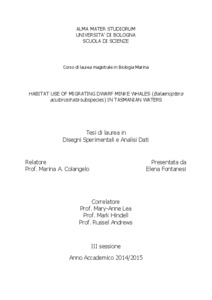Fontanesi, Elena
(2016)
Habitat use of migrating dwarf minke whales (Balaenoptera acutorostrata subspecies) in Tasmanian waters.
[Laurea magistrale], Università di Bologna, Corso di Studio in
Biologia marina [LM-DM270] - Ravenna
Documenti full-text disponibili:
![[img]](http://amslaurea.unibo.it/9754/1.hassmallThumbnailVersion/Fontanesi_Elena_tesi.pdf)  Anteprima |
|
Documento PDF
Disponibile con Licenza: Salvo eventuali più ampie autorizzazioni dell'autore, la tesi può essere liberamente consultata e può essere effettuato il salvataggio e la stampa di una copia per fini strettamente personali di studio, di ricerca e di insegnamento, con espresso divieto di qualunque utilizzo direttamente o indirettamente commerciale. Ogni altro diritto sul materiale è riservato
Download (1MB)
| Anteprima
|
Abstract
The Great Barrier Reef hosts the only known reliable aggregation of dwarf minke whale (Balaenoptera acutorostrata subspecies) in Australian waters. While this short seasonal aggregation is quite predictable, the distribution and movements of the whales during the rest of their annual cycle are poorly understood. In particular, feeding and resting areas on their southward migration which are likely to be important have not been described. Using satellite telemetry data, I modelled the habitat use of seven whales during their southward migration through waters surrounding Tasmania. The whales were tagged with LIMPET satellite tags in the GBR in July 2013 (2 individuals) and 2014 (5 individuals). The study area around Tasmania was divided into 10km² cells and the time spent by each individual in each cell was calculated and averaged based on the number of animals using the cell. Two areas of high residency time were highlighted: south-western Bass Strait and Storm Bay (SE Tasmania). Remotely sensed ocean data were extracted for each cell and averaged temporally during the entire period of residency. Using Generalised Additive Models I explored the influence of key environmental characteristics. Nine predictors (bathymetry, distance from coast, distance from shore, gradient of sea surface temperature, sea surface height (absolute and variance), gradient of current speed, wind speed and chlorophyll-a concentration) were retained in the final model which explained 68% of the total variance. Regions of higher time-spent values were characterised by shallow waters, proximity to the coast (but not to the shelf break), high winds and sea surface height but low gradient of sea surface temperature. Given that the two high residency areas corresponded with regions where other marine predators also forage in Bass Strait and Storm Bay, I suggest the whales were probably feeding, rather than resting in these areas.
Abstract
The Great Barrier Reef hosts the only known reliable aggregation of dwarf minke whale (Balaenoptera acutorostrata subspecies) in Australian waters. While this short seasonal aggregation is quite predictable, the distribution and movements of the whales during the rest of their annual cycle are poorly understood. In particular, feeding and resting areas on their southward migration which are likely to be important have not been described. Using satellite telemetry data, I modelled the habitat use of seven whales during their southward migration through waters surrounding Tasmania. The whales were tagged with LIMPET satellite tags in the GBR in July 2013 (2 individuals) and 2014 (5 individuals). The study area around Tasmania was divided into 10km² cells and the time spent by each individual in each cell was calculated and averaged based on the number of animals using the cell. Two areas of high residency time were highlighted: south-western Bass Strait and Storm Bay (SE Tasmania). Remotely sensed ocean data were extracted for each cell and averaged temporally during the entire period of residency. Using Generalised Additive Models I explored the influence of key environmental characteristics. Nine predictors (bathymetry, distance from coast, distance from shore, gradient of sea surface temperature, sea surface height (absolute and variance), gradient of current speed, wind speed and chlorophyll-a concentration) were retained in the final model which explained 68% of the total variance. Regions of higher time-spent values were characterised by shallow waters, proximity to the coast (but not to the shelf break), high winds and sea surface height but low gradient of sea surface temperature. Given that the two high residency areas corresponded with regions where other marine predators also forage in Bass Strait and Storm Bay, I suggest the whales were probably feeding, rather than resting in these areas.
Tipologia del documento
Tesi di laurea
(Laurea magistrale)
Autore della tesi
Fontanesi, Elena
Relatore della tesi
Correlatore della tesi
Scuola
Corso di studio
Ordinamento Cds
DM270
Parole chiave
Satellite tagging, Generalised additive model, Migration, Bass Strait, Storm Bay, Cetacean
Data di discussione della Tesi
18 Febbraio 2016
URI
Altri metadati
Tipologia del documento
Tesi di laurea
(NON SPECIFICATO)
Autore della tesi
Fontanesi, Elena
Relatore della tesi
Correlatore della tesi
Scuola
Corso di studio
Ordinamento Cds
DM270
Parole chiave
Satellite tagging, Generalised additive model, Migration, Bass Strait, Storm Bay, Cetacean
Data di discussione della Tesi
18 Febbraio 2016
URI
Statistica sui download
Gestione del documento:


 Login
Login
